Misyon Online - March-April 2008
A Life Beyond Imagination
Father Mulroney interviewed Columban lay missionary Jhoanna ‘Jao' Resari in the middle of her three-year term in Taiwan which will finish around Easter.
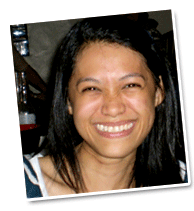 I have learned things about myself I never dreamed existed', said Jhoanna Resari about her experience as a Columban lay missionary in Taiwan. Jao was in Hong Kong on her way to mainland China to visit two of the six Harmony House foundations for HIV and AIDS people and to learn about the care of patients and the organizational facets of running facilities. The 28-year-old graduate in fine arts from the University of Santo Tomas in Manila explained that she was always on the look out for ‘something' which she could not quite define, and said that, as an undergraduate, she used to pray hard asking God to show her a way.
I have learned things about myself I never dreamed existed', said Jhoanna Resari about her experience as a Columban lay missionary in Taiwan. Jao was in Hong Kong on her way to mainland China to visit two of the six Harmony House foundations for HIV and AIDS people and to learn about the care of patients and the organizational facets of running facilities. The 28-year-old graduate in fine arts from the University of Santo Tomas in Manila explained that she was always on the look out for ‘something' which she could not quite define, and said that, as an undergraduate, she used to pray hard asking God to show her a way.
Wisdom is for Everyone
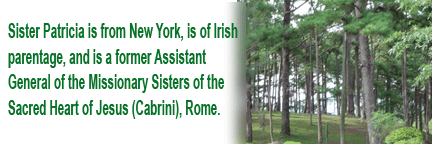
Paradoxes of the Cross
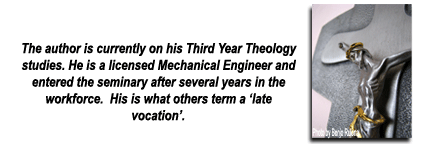
A Spring Flower
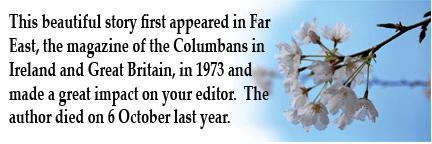
A Life Beyond Imagination
 Father Mulroney interviewed Columban lay missionary Jhoanna ‘Jao’ Resari in the middle of her three-year term in Taiwan which will finish around Easter.
Father Mulroney interviewed Columban lay missionary Jhoanna ‘Jao’ Resari in the middle of her three-year term in Taiwan which will finish around Easter.
I have learned things about myself I never dreamed existed’, said Jhoanna Resari about her experience as a Columban lay missionary in Taiwan. Jao was in Hong Kong on her way to mainland China to visit two of the six Harmony House foundations for HIV and AIDS people and to learn about the care of patients and the organizational facets of running facilities. The 28-year-old graduate in fine arts from the University of Santo Tomas in Manila explained that she was always on the look out for ‘something’ which she could not quite define, and said that, as an undergraduate, she used to pray hard asking God to show her a way.
‘I went to church for Mass one Sunday’, she went on. ‘It was my first time at that church and when I came out a huge banner had been stretched across the courtyard with the words Columban Lay Mission written on it and people were there giving out information about going overseas. I thought that this was the answer to my prayer’, she smiled, ‘so I asked about joining’.
However, she was told she didn’t qualify as they only accepted people with at least three years working experience. ‘So after graduation I took a job as a graphic artist’, she explained. ‘But the feeling didn’t go away’. She said that she had not forgotten the day at the church and the idea of working in a cross-cultural situation began to attract her. When her three years were up, she contacted the lay mission program. ‘I still had the brochure’, she revealed. I realized that I am not going to live forever and I knew that I wanted to do something meaningful while I am still young’. Jhoanna said that although leaving home was hard, she was delighted at the support her three sisters and brother gave her. ‘My brother is still in school’, she explained, ‘and I was aware that the family had to be in agreement as I would not be earning money. I could not contribute towards expenses at home’. She said that her mother and father cried at first, but ‘they really understood it was what I wanted and have been very supportive’. She describes this decision as being the beginning of a whole new experience in the life that has taught her how to make her own decisions, to live away from her family and feel God’s presence deeply. ‘People have been a great blessing and they have helped me to grow into the person I am today’, she explained. ‘And I really like who I am’, she beamed.
‘I knew that I wanted to do something meaningful while I am still young’.
Jhoanna explained how her missionary life began in Manila with a nine-month preparation course. ‘We studied scripture, theology, sociology, anthropology, history and all sorts of wonderfully interesting things’, she expanded, ‘and I did three months of CPE (Clinical Pastoral Education) with patients and staff at Makati Medical Center’. This was topped off with an exposure experience in the predominantly- Muslim Marawi City in Mindanao. ‘I was learning things I never dreamed of!’ Now after a year-and-a-half in Taiwan, Jhoanna does not describe herself as a hardened missionary, but says, ‘I am only just beginning’. She elaborated how she studied Mandarin full-time during her first year and then began work at Harmony Home Association, Taiwan, a center for the care of babies and mothers who are HIV-positive.
‘I do the office work’, she said, ‘but bit by bit I am learning how to look after the babies who were born HIV-positive and to do other patient support work.’ She explained that, if treated properly, the babies have a chance of being cured, so their time in the center, which was founded by Nicole Yang, a long-time carer of patients with AIDS, is vitally important for them.
She also spoke of the stigma attached to HIV and AIDS. ‘People in the locality have objected to our presence there’, she said, ‘and right now we have a case in the Supreme Court about our tenancy’. Jhoanna said that the center has responded by beginning education program in the local area. ‘Our people are going into schools and out to meet other groups’, she said. ‘It has had a good effect and we are getting a lot more local support now’.
‘Sometimes people ask me about my plans for the future’, she shared, ‘but right now I feel like I am only just beginning. I have a three-year contract with the Missionary Society of St Columban and I can renew it at the end of that time’. She said that right now she is concentrating on ‘strengthening my relationships with people in Taiwan’ and dreaming about ‘speaking Mandarin properly’.
She noted that ‘when I feel I can get back to my fine arts and paint again, I will know that I have settled’. Father Mulroney interviewed Columban lay missionary Jhoanna ‘Jao’ Resari in the middle of her three-year term in Taiwan which will finish around Easter.
You may contact ‘Jao’ Resari at
resarijao@yahoo.com
A Life Of Service To The Filipino People
By: Father Donal O'Hanlon SSC
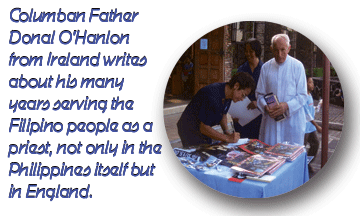
My First Holy Communion at the age of seven was one of the most important experiences of my life. After coming home from the church that day, my mother sent me out to the farm to call the workmen for lunch. I felt Jesus physically present to me. I stopped and told him that I would always do his will. My father noticed my prayerlife and encouraged me to be a priest. I responded negatively. He died when I was 11 years old. His death had a profound influence on me. The most traumatic experience of my life was the sudden death of my mother five years later. At that time the call to priesthood was so insistent that I made a decision to be a priest and never questioned it. My first three years as a seminarian for my home Diocese of Cloyne were spent in St Patrick’s College, Maynooth, Ireland’s national seminary. Then I decided to join the Columbans and spent the next five years at their seminary in Dalgan Park where I was ordained a priest by Bishop Patrick Cleary on 21 December 1959. Bishop Cleary had been a professor in Maynooth but joined the Columbans in 1918, the year the Society was formally established. He later became Bishop of Nancheng, China, but was expelled in 1952.
Now the real adventure started – mission work. After a long land and sea voyage I finally arrived in Ozamis City, Philippines, in November 1960 and started the tedious and essential work of learning a new culture and language. The course lasted for six months but in a very real sense continued throughout the remaining five years of my first term on mission.
In 1967 I became parish priest of Dimataling, a remote rural area, four hours by sea from Pagadian City. At the time there were no roads leading to it. It had 40,000 Catholics with 72 villages and two priests. This is where I believe I made the greatest contribution to pastoral work in the Philippines.
I set out to maximize lay participation. I asked for two male leaders from each of the three strongest Catholic communities to sit down for a week with me while we brainstormed on what pastoral programs we should adopt. We prayed for guidance and decided to start a Sunday Prayer Service, Katilingbanong Pag-ampo, in each community. The experiment was successful. After six months we requested 60 male leaders from 30 communities to attend a seminar where they were trained to conduct the Katilingbanong Pag-ampo. This was mainly successful. Finally the program was expanded to include all 72 communities.
But empowering people demands much training in skills and all the male leaders were invited for a five-day training seminar. This became an annual event. Then the parish was divided into six zones and I spent a full day each month with the leaders of each zone. Then two female leaders and two youth leaders were chosen by each community. Each group, male, female and youth, had their own individual monthly meeting at zone level. The women took care of the catechetical instruction in the local public schools and the youth developed their own programs. Each community was called a Basic Christian Community. Four years into the program, the Redemptorists were invited to give a parish mission which was successful because of the presence of trained leaders in each village. Bishop Jesus Y. Varela, then auxiliary of the Archdiocese of Zamboanga, visited and administered the sacrament of confirmation to 4,000 in the six zones.
A very important event, the first Mindanao-Sulu Pastoral Conference, took place in Davao in 1972, called by Archbishop Lino R. Gonzaga of Zamboanga, attended by all the bishops and selected priests and lay people. At this time a Passionist Father had also developed Basic Christian Communities (BCCs) in the then Prelature of Marbel and the Maryknoll Missionaries a highly developed program in the Prelature of Tagum. The BCC Program was adopted by the First Mindanao-Sulu Pastoral Conference as a basic pastoral plan for the whole of Mindanao-Sulu. I had the joy of adapting the same program in two subsequent parishes, Aurora, Diocese of Pagadian (1972-1977) and Margosatubig, Prelature of Ipil (1984-1988).
From 1978 to 1982 I worked at the Filipino Chaplaincy in London, England. This was a period of great turmoil as about 300 Filipinos were picked up for deportation. After an intensive campaign in the media only a few were actually sent home. Also, a constant stream of Filipinos left abusive employers and came to the chaplaincy for protection. Eventually as many as 4,000 escaped. The status of most of these was subsequently regularized under Prime Minister Tony Blair. For this magnificent achievement, credit is mainly due to Columban Father Aodh O’Halpin and Sr Margaret Healy, a St Louis Sister, both working with KALAYAAN, Campaign for Foreign Domestic Workers. Father Aodh worked in Mindanao for many years and his older brother Father Colm, also a Columban, is buried in Kabankalan City, Negros Occidental.
Working in Mission Awareness from 1989 to 2007 in the Columban Northern District of the Philippines was a time of great joy for me. Based in Manila, I made friends in Catholic schools and parishes from Aparri in the north to Maasin, Dumaguete and Iloilo in the south. It gave me much satisfaction to see Misyon subscriptions grow to the present 36,000 or so nationwide. Working with Columban Sister Patria N. Daomilas, a native of Misamis Occidental and totally committed to Misyon as a vehicle of mission awareness, was a great source of inspiration.
During this period I was instrumental in setting up two powerful apostolic groups. One was ‘Inter- Congregational and Lay Mission Awareness’ (ICALMA), a dedicated group of priests, sisters and lay people who worked with me for five years in Manila giving seminars to teachers, mainly in public and private schools with no Church affiliation. The topic that ran longest was ‘Life in a Broken World’. The group stopped when most of the facilitators were assigned to positions which didn’t leave them free to volunteer.
Since 1992 Columban Companions in Mission (CCIM), has been another group of dedicated lay people who have made a substantial commitment to mission. They have supervised and managed the sale of Misyon in more than 150 churches in Manila and surrounding dioceses over the past ten years where Columban priests spoke on Mission Awareness and Misyon. They also developed an outreach program to the poor that includes the supervision of the education of 30 slum children and catechetical instruction of abandoned and sexually abused children of Virlanie Foundation, Inc (VFI). Monthly visitation of prisoners in Muntinlupa, the National Penitentiary, has been a regular part of their work. Ten vocations to a full-time commitment have come from the group – two priests, four sisters and four Columban Lay Missionaries.
From the very beginning of my priestly ministry in the Philippines, preferential preference for the poor has been basic to my priesthood. This blossomed through the BCCs in three parishes and through the outreach programs of the CICMs in Manila and through my personal contacts over 47 years. The development of talents, leading to more skills and better opportunities of getting employment, has always been my way of acting but there are times when it is difficult to refuse a handout when faced with sheer and utter misery.
The years from 1960 to 2008 have been for me a period of great joy and total commitment to the Filipino people. If given the chance to live my life over again, I would not change anything. I want to acknowledge all the people along the way who have made my life of service to the Filipino people possible and fruitful.
A Priest, I Bless You - Alberto
Fr John Griffin, a Columban ordained in 1950, worked for many years in Zambales. He was later assigned as a missionary in Chile. At present he works in Lower Hutt, near Wellington, the capital of his native New Zealand.
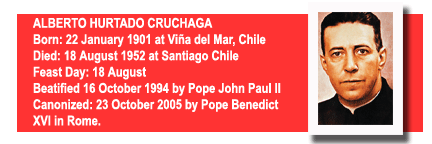
The name of Chilean Jesuit priest Alberto Hurtado, who succumbed to pancreatic cancer in Santiago, Chile, on 18 August 1952, has long been nationally venerated, but now more than ever following his canonization by Pope Benedict XVI in 2005. He is Chile’s second saint, following the canonization in 1995 of Sta Teresa de Los Andes, a young Carmelite novice.
The saint’s father was murdered by rustlers when Alberto was only four. This forced his mother to sell the farm, settle all debts and move with her two small sons to Santiago. There they depended on the charity of her brother and other relatives who took turns in sheltering them and giving them a home.
At eight years of age Alberto gained a scholarship to San Ignacio College, administered by the Jesuits, and he was there for the next nine years. He and his classmates deeply admired one of their teachers, Fr Fernando Vives.
He was a man who took seriously the social implications of the Gospel teachings and of the Encyclical Letter of Pope Leo XIII, ‘Rerum Novarum’ and he instilled a lasting social conscience in most of his students.
Prior to graduating from San Ignacio in 1917, Alberto applied to enter the Jesuit Novitiate, but since he was only 16 he was advised to wait. He began to study law at Santiago’s Catholic University. In August 1923 he was admitted to the Jesuit Novitiate located in Chillan, 400 kms south of Santiago, and two years later was sent to Argentina to continue his spiritual formation. This meant a painful separation from his widowed mother whom he was not to see again until 11 years later.
For the study of theology the group was sent to Louvain in Belgium and there Alberto was ordained on 24 August 1933. He conveyed this good news to his mother in the simplest of telegrams, ‘A priest, I bless you – Alberto’ and returned to Chile at the beginning of 1936.
Following a joyful month’s holiday with his mother and family in Santiago he received his assignment – back to the scene of his secondary studies, San Ignacio College. He also became a part-time professor at the Archdiocesan Major Seminary and the Catholic University.
Overall, Fr Hurtado is best known and remembered throughout Chile for his ‘Hogar de Cristo’ (Christ’s Home) Foundation. The seed for this was sown late one night when he was on his way home to San Ignacio. He met a man who was in poor health, had eaten nothing all day and had nowhere to go.
This was the priest’s first encounter with such poverty and it moved him greatly. He did what he could for the man and then asked: ‘What are our Catholics doing for those who have no roof over their heads?’ He began asking this question during his retreats and so was born the idea of ‘Hogar de Cristo’. He formed a board of directors from people eager to help – six men and 30 women. Land was available alongside the Jesuit parish of Jesus the Worker and the first night-shelters were built and an appeal for funds began. By 1945 there were five shelters that had been able to house 12,000 poor men. Now it was time to do something for the numerous ‘street kids’ who spent their nights under the many bridges over the Mapocho River which runs for miles through Santiago. These youngsters needed educations as well as shelter and land was donated for this purpose a few miles to the north of the city near Colina railway station and a children’s home was built.
It was immediately obvious that such youngsters needed some sort of a trade to make their future secure, so different workshops were built. Fr Hurtado was confronted by another question: ‘How many such homes and workshops are needed up and down Chile to tackle the problem of child vagrancy?’ Something, he said, that should be of concern to all Chileans.
Providence was always on his side. At a meeting one night his board of directors was unwilling, for lack of funds, to approve a new project. In the midst of discussions there was an unexpected call for Fr Hurtado to attend to someone at his front door. He had a brief conversation with the caller who said she wanted to leave a gift to help the great work he was doing.
He gratefully put her envelope in his pocket, wished her a good evening and returned to his meeting. He looked at the contents of the envelope as he sat down. Then he tossed a check onto the table saying, ‘There you are, ye of little faith!’ It was for one million pesos – worth about US$30,000 at that time.
Through radio talks, public lectures and articles in the press, Fr Hurtado appealed untiringly in the name of the ‘Home of the Homeless’. He acquired a green truck that became well known around Santiago as he went looking, especially on winter nights, for ‘clients’ whom he would take to a coffee shop for something hot, then drive them back to where a clean, warm bed was waiting for them.
Suddenly, in April 1952, his health began to deteriorate. He took a couple of rest periods but there was no improvement. Friends convinced him to see a doctor who made several tests that revealed that he had cancer of the pancreas. On 19 May he celebrated the Eucharist at San Ignacio but this proved to be his last Mass as later that day he suffered a serious heart attack and was taken to the hospital of the Catholic University.
Word spread quickly and a continual stream of visitors came to see him. His great delight was to receive his earlier waifs and strays, many of whom were by now successful businessmen. His peaceful death took place in the late afternoon of 18 August 1952.
On 5 November 1991 the late Pope John Paul II declared him ‘Venerable’ and then ‘Blessed’ on 16 October 1994. Pope Benedict XVI declared him ‘San Alberto’ on 23 October 2005.
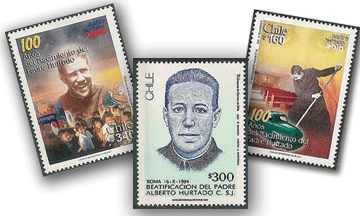
You may email the author at
jgriffin@paradise.net.nz or write him
at: St Columban’s, PO Box 30-017,
LOWER HUTT 5040, NEW
ZEALAND
A Spring Flower

There is a high school in our parish for nearly 2,000 girls conducted by the Sisters of the Infant of Jesus. Very few of these girls are baptized Christians. As a means of contact, I teach English to the junior high school pupils three times a week. My classes are very informal and I am afraid the young ladies don’t take me very seriously, possibly because I give them no homework or exams. My specialty is supposed to be pronunciation and intonation.
One day, early in November 1971, I received a summons from one of my little pupils, Keiko Uemura, aged 14. She was very sick in the hospital and wished to be baptized. I hadn’t noticed her absence at school. The nuns were full of apologies for not letting me know, This beautiful story appeared in Far East, the magazine of the Columbans in Ireland and Great Britain, in 1973 and made a great impact on your editor. The author died on 6 October last year. but they hadn’t thought her illness was serious; moreover, she had never shown any real interest in religion but on the contrary, during religious classes seemed to take a delight in trying to tie the Sister up in knots with embarrassing questions.
Young and faithful
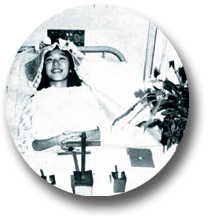
Keiko on her First Communion Day
When I visited her she seemed in good spirits. After ascertaining that she really did believe and had sufficient knowledge to realize what she was doing, I baptized her. A few days later I returned to the hospital with several books that explained the faith simply and would help her to pray. She began to prepare for her first Holy Communion. I discovered that despite her seemingly frivolous behavior during religion classes, she had retained quite a lot and what was more, in her present crisis could believe, simply and totally, with no reservations.
In December she was moved to the University hospital, the largest in town and the best equipped. Keiko herself was not aware of it, but she was suffering from a rare type of bone cancer that sometimes afflicted children. The doctor gave her three months to live. Her parents were wonderful. One of them was always near her, day and night. In her case this devoted warm parental love was an actual grace that served to open out and expand her soul to receive the grace of God’s love. As Keiko responded to God’s love, the change in her thinking and outlook, her values, could not fail to impress her parents who in turn were drawn along by the girl towards God.
About Christmas time she made her first Holy Communion. She was radiantly happy that day, as is evident from the photo. Present for the occasion were her parents and some of the Sisters from the school. I made a tape recording for future use. Each week I took her Holy Communion. Her mother prepared the altar and with Keiko read the book on doctrine explaining the faith.
Home for the New Year
The girl was permitted to return home for three days over the New Year. As a result of an operation she had recovered so well that she could walk about slowly with the aid of crutches. She believed she was on the way to complete recovery; she was full of roseate plans for her future, a trip to Lourdes followed by a life of service as a nurse to crippled children. Her father hoped against hope for a miracle, but on the quiet he assured me that it was only a question of time.
Spiritual progress
During the next three months she made tremendous spiritual progress. Her mother told me that she herself was sometimes concerned by the flood of visitors, who often outstayed their welcome, even when Keiko was in pain. But the girl never showed it; she always put on a cheerful front and showed her gratitude to all-comers. Later when her mother grumbled about the inconsiderateness of some people, the girl stopped her with: ‘Mother, it may be alright for you to complain because you are not a Christian, but I am one now and must love everybody. Besides, the visitors come because they are interested in me and I am grateful for this.’ Apart from the occasional sigh or moan that escaped her lips, she never complained of the pain.
As the long winter faded, the cherry blossom trees along the Shirakawa River responded to the warm April sun and flooded the banks with a soft pink mist. I could see the blossoms from the window of her room, but the girl was too young to appreciate the pathos of their beauty – those petals whose destiny was to diffuse their delicate beauty for a brief span, only to be caught by the slightest breeze and flutter to the earth from which they sprang. Keiko never saw her own life and destiny in those blossoms.
About the middle of April she began to weaken. Within a week, she had lost consciousness and was given oxygen. She died peacefully on 27 April. The church was filled at her funeral. Her classmates were heartbroken and inconsolable, far more emotionally upset than her family. Indeed, I was surprised at how calmly her parents bore their great loss. I discovered it was because they had received the grace of the faith through the girl’s influence, even before they had begun any formal instructions. They were convinced that she still lived on in God and that they would meet her again.
Whole family converted
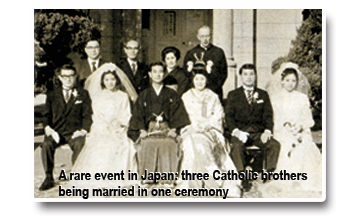
A week after the funeral her parents and her brother began their study of the doctrine. They were model catechumens. Every night before the family altar, united to Keiko in spirit, they said the rosary and read a chapter from the Scriptures. I baptized them on 6 November, the anniversary of Keiko’s baptism. There were tears of joy in their eyes that day as they realized they were united to their daughter by grace within the bosom of God the Father.
One of Keiko’s closest friends who was shattered by her death but very impressed by the spiritual change in the girl before her death, has resolved to follow in her footsteps and pursue the ideal of service Keiko set for herself had she lived. She is now under instructions and intends to become a nurse.
Testimony of her faith
There was nothing sensational about this girl’s short life. She did nothing that would merit notice in the mass media; her life created no more of a stir in society than a petal falling to the ground. But I am convinced her story is real news and a genuine success story. In these days of superficial sensationalism, even we Christians tend to forget that the real battles of life are won or lost within the depths of the heart where a man meets his God and says yes or no.
Moreover, in a country like Japan, a missioner seldom sees the grace of God’s action working so powerfully and swiftly in a soul. Such tangible evidence of God’s presence is almost a physical sign of His love which bolsters one’s hope no end, enabling the missioner to keep going. This slip of a girl was a candle in the darkness, a spring flower in the desert.
God Cares
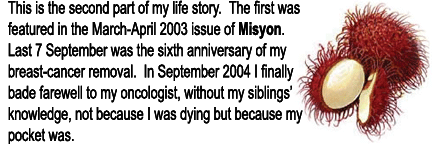
[Editor’s note: You may read Elena’s article, ‘I Thought God didn’t care’, at www.misyononline.com by typing her name in the search box].
I told my oncologist honestly that I was running out of finances to continue treatment. I was supposed to have regular checkups for at least five years and go through a series of laboratory tests. Cancer is a wasting disease both to the patients’ health and their pockets. It drains money by the thousands and even millions for the rich.
I could not, for the rest of my life, survive on ‘dole outs’ from my siblings considering that they have families of their own to support. They were opposed, of course, to my decision to stop seeing my doctor. Although at my age now (68) I belong to the so-called ‘endangered species’, come what may, I must be practical and yet fight cancer to the very end by way of guts and courage through prayer and constructive thinking. I assured my brothers that with divine intervention I will enjoy more years of life beyond cancer, minus medications. I was confident enough. I could feel it. Anyway, we’ll all go eventually because we’re all living on borrowed time.
A born winner
I told myself, ‘Be strong to face the consequences in the coming days. From now onwards no more anti-cancer drugs for you. You should wake up to the reality that I can only provide you with supplements. That’s all.’ People close to me say I am queer, funny and gutsy in the sense that I gamble with life unnecessarily. But for me, there is no unnecessary gambling because life itself is a gamble . . . a game.
Where there is life there’s always a challenge. Without it, life would have no direction, purpose or meaning at all. What matters is how to handle it. Life is a journey on rough roads, it is said. Yes. It is. Yet, the road ahead may be smoother. Hopefully.
Someone commented that I am both a joker and a fighter. Yes, I am and even more than a fighter, I am a bornwinner . . . not of prosperity or opportunities but rather of adversities, struggles and challenges. No hard feelings. All these I offer to the Lord for His greater glory. I have learned a lasting lesson after putting up a fight with Him in the past. It brought me nowhere and I ended up turning back to Him for sanctuary. Those were the days. Now, this explains why I turn to praising Him in spite of pain.
Living life
Whenever I have the chance, I reach out to cancer–stricken individuals to bring them hopeful news about cancer and my experiences with it, spiced with humor to perk them up. Some are accommodating and appreciative, asking for more visits, which I gladly do. Some are less responsive, like those sporting an end-of-the-world look in spite of their fortune.
Many cancer patients I have known gave in to too much self-pity. There were cancer patients who would have recovered gradually and regained health had they not indulged in it. Self-pity kills. They believed that cancer is synonymous with mortality. NO. It is not. It is how you look and handle it. Look at things positively always. Let us by all means be positive in our outlook and attitudes towards life, by turning impossibilities into possibilities.

Last year on 20 February I had my gallstones removed. I checked out the following day, with the doctor’s approval, took a leisurely walk at the mall to shed off the effects of the anesthesia and to reactivate sleeping organs.
Two sides of cancer
In my case, I would say that cancer has two sides to it, what I call the takeit and leave-it sides. TAKE IT. . . seriously, be very sorry for yourself. Then your days are numbered in spite of your fortune. One could go before his time earlier than expected if negativity of mind prevails. LEAVE IT . . . to the will of God. Pray and relax. Accept and trust. Enjoy more fruitful years of life beyond cancer. LET US FIGHT CANCER TO THE END! This may be challenging yet amusing but let’s declare, ‘NO DEAL WITH CANCER!’
Based on experience, I think the moneyed and the less privileged differ in attitude on the matter in the sense that the latter don’t mind or create so much fuss over health problems because they lack time, or may have none at all, to think about it. For me, I don’t have time to give it a thought.
I get weary when my work is done at the end of the day. Tired but not dispirited. I am kept busy by my day-to-day struggles for survival. I read books on cancer extensively. This explains why cancer is no longer a stranger to me. Although treacherous, since it recurs anytime, we are given time to prepare ourselves before it brings us to the next life.
What tomorrow holds
The beautiful lines by one cancer victim, ‘I do not know what tomorrow holds but I know who holds tomorrow’ is something for us to reflect on. It is a wake up call that we must at all times keep ourselves ready to face That-Holder-Of- Tomorrow-Up-There when He beckons us to the next life one day to stand before Him because He will do an audit of our life.
I usually feel discomfort around the lumbar area of my spine. I readily attribute it to osteoarthritis. When pain strikes I say ‘Lord, if this is it – metastatic cancer – so be it. Your will be done. But, Lord make it bearable for me’. Christ Himself suffered. He knows what it is to suffer.
It may sound funny but the truth is I don’t feel like dying at this point in time. I feel there are still little things to attend to before my time is up. Hopefully, I can make it before the bell tolls for the final call.
Now I am into small farming, planting corn and backyard gardening, planting vegetables. I may consider orchid-raising again if time permits. For the past four decades I was so engrossed in my work that I didn’t notice how time had passed until cancer almost took me. Life goes beyond cancer! Earlier I was considering going back to school. I’ve never been to any higher institution of learning, which explains why I have always craved for a taste of college life. Everybody laughed at me. Past midnight already, they said. Education is a continuing process. Now what prevented me from pursuing it was that one culprit – my high school card. The majority of my grades seemed to have just checked out of the intensive care unit, sickly and poor ratings.
My thanks
I would like to express my sincere thanks and gratitude to the people from far-flung areas who, although unknown to me, wrote me letters of concern and prayers after reading my story in Misyon. To the people around me, relatives and friends, thank you for your support. To my beloved brothers and their families, thank you for your love, concern and attentive care. I understand you’ll all miss me when I am gone forever being the only rose among the thorns, though faded and withered, battered by time. Joke only. Thank you very much in advance for helping me make it through the night. It is a touching consolation for an ‘old rose’ to see herself surrounded by colorful young butterflies (nephews, nieces and grandchildren) who admire and adore this ‘flower’ although devoid of its tenderness, color and scent. Beauty lost forever. Joke only. Excuse me, but I do love jokes because I love to make people laugh if possible. It drives boredom away. At times they are jolted by my directness and honesty. God loves to play jokes too, though painfully sometimes.
Hopefully, I will be able to contribute another write-up on my experiences of cancer and my courageous fight with it through prayer and positive thinking about the future, if God blesses me with more years of life. Thank you Lord for giving me strength and courage to face what lies ahead.
You may write to:
Elena Ang
Sta Cruz, Jimenez
7204 Misamis Occidental
PHILIPPINES
Just For Youth: Cell Phone

I love my cell phone. I enjoy texting. I don’t know what I will do if I lose this cell phone. That could instantly stop my communications and at this point, that is how I mainly keep in touch with my family, the staff I work with in our organization, our hundreds of contacts (yes, my phonebook can carry a thousand names) and the nuns – most of them, even our 82-year-old Sister, have a cell phone now.I text fast, especially when I put it in the dictionary mode. I am awed at how the right word comes out and tells you if your spelling is wrong. I don’t care too much about using text language. Sometimes, I can hardly understand messages that come into my unit: FYI / BTW/ GB / TYVM. Or: ‘Gdpm,Sr. pwd b mgtn0ng?ksi po d n sumsagt bf k s mga txt ko. May ngyri samn n0ng 1 gabi. Sb nya mahal nya k0 pr0 bkit d sya sa2got? An0po ga2wn ko?’ Although I am learning how to read them now. And starting to txt that way too! . . .You see, I don’t only own a Communicator . . . I am also a COMMUNICATOR! I am a writer, lecturer, a radio announcer and a TV host. I have been writing for our school organ since high school and until now I submit articles to magazines, newspapers, and lately to websites. I conduct seminars on health, values education (especially for teens and their teachers), responsible parenthood lectures to couples in urban poor communities, and talk at international pro-life conferences . . .
In my writings, talks, radio and TV shows, I always announce my cell phone number to let people know that we, in pro-life, are available for counseling. We also receive prayer intentions and forward them to Contemplative Nuns who include those intentions in their daily prayers. And people do text me. I am surprised at the number of boys and girls, men and women who want to communicate . . .

Because of the cell phone, I am in touch with thousands of people from all over the country. We are connected so quickly – our thoughts and desires united within a few minutes. This is something that never happened in the past. Modern technology has allowed all these good advantages to happen.
I know that the cell phone is almost like another hand and eye and ear for a teenager. Though, when the cell phone becomes an obsession and the teen doesn’t pay attention anymore to the adults because of being ‘hooked’ to that little piece twenty-four hours,this is where common sense and discipline must come in. It does take self control not to open the message and reply ASAP. Except for doctors, I don’t think any message is a matter of life or death. So waiting to read it till the class or Mass is over will not kill you. Not answering messages from strangers is also a good advice. I have received some depressed counselees – victims of abuse or foolish relationships which all started by answering the ‘pwede ka bang maging textmate ko?’ The persons pressing those sweet words could be hiding behind a dozen lies – their age, sex, civil status and job, if they have any. Obscene and violent words have also been sent to me. My natural instinct and curiosity makes me REPLY but I hold back, whisper a short prayer and commend to the Lord this person – who really does need God’s mercy and guidance at that moment.
I am also very good at turning off my cell phone whenever I am in Church, attending a lecture, watching movies (whether in a movie house or videos at home with the nuns) and while counseling. I hate being disturbed when I myself am giving talks so I give due respect to others when they need my attention. I turn it off also at bedtime so the people near me can enjoy their good night’s rest. In case of emergency, my family and the nuns from other convents can call us on the landline anytime.
Lastly, I do not text while walking. I learned that the hard way. I tripped one time because I did not see a hole on the driveway. Thank God I did not fracture my leg, only sprained my right ankle. But how it hurt for three weeks!
I consider my cell phone an instrument that God (author of science and technology) has given me. I like it but I am not attached to it. I depend on it in many ways. But there are other alternatives in case I do not have it. I use it to be able to communicate, to bond, and to reach out to people, especially those in need.

Paradoxes Of The Cross

The Cross-event is the selfrevelation of God in the form of a three-fold love. As Catholics we believe that on the Cross we can find the love of God the Father for Jesus Christ, the love of the Son for His Father and the love that is given and received for humanity, the Holy Spirit. It is from the Cross that we come to know the will of the Father for His Son, the acceptance of the Son of the Father’s will and the overflowing love of the Father and the Son who both suffer for the sake of humanity.
The breakdown in the Cross is the context of the breakthrough for the Resurrection. I can say that the identity of the Risen Christ is destroyed when we forget the Cross where Christ was crucified for all. Sad to say, some faithful are so engrossed in the Resurrection that the death of Christ, which should be given emphasis as well, has been ignored. Only by attending to the Cross in the light of the Resurrection, and to the Resurrection in the shadow of the Cross can we begin to grasp deeply and fully the meaning of the inseparable saving Death and Resurrection of Jesus Christ.
At first glance, the self-revelation of God on the Cross appears to be a cobweb of confusion. It is such because it is basically paradoxical in character. Why? I have come across His presence in silence, His power in weakness and His light in darkness. But after asking for and receiving divine guidance, I have realized that it is through these paradoxes that the message shines all the more brightly.
It is in the seeming silence of God on the Cross that His love for His Son is fully and immutably expressed, like a good parent who knows the possibility of falling and being hurt yet one day allows his kid to take his first steps alone; because the child will only learn to walk by walking by himself. While Christ was hanging on the cross His Father was definitely there looking at Him with love, silently but truly, warmly embracing Him and allowing Him to yield His spirit. This is enabling love – the love that does not spoil, the love that does what is needed to be done for the good of the beloved, the love of God for us, the love that we need as persons with intelligence and freedom.
Likewise, it is from the seeming weakness that the real strength comes. A good father simulates a serious struggle with his son and allows himself to be defeated. He does this not only to humor the child but to encourage the latter to be strong and to do his best in everything he undertakes. What happened on the Cross was for real, it was no simulation at all. The Father did truly allow himself to become weak, as it were defeated, when His only begotten Son really died on the Cross to establish the new and much stronger, in fact, everlasting covenant with us. The weakness of God on the Cross overcame once and for all the power of evil, sin and death.
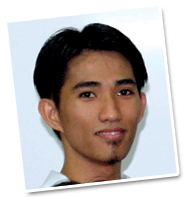 It is in the darkness, on the other hand, that we can see the light. This is what happened on the Cross. Christ needed to pass through the darkness of death in order to give light of life to humanity. His death is saving and leads to resurrection because he clearly embraced it with love for the Father and for us. This is our call as well.
It is in the darkness, on the other hand, that we can see the light. This is what happened on the Cross. Christ needed to pass through the darkness of death in order to give light of life to humanity. His death is saving and leads to resurrection because he clearly embraced it with love for the Father and for us. This is our call as well.
The experience of the Cross in one form or another is a universal human experience with which everyone can identify. The Cross is a sign of love. Being a lover of Christ is not that easy. It entails sacrifice, a sacrificial love. Certainly, life here on earth is a mixture of joys and pains; yet sometimes it is the pain that is dominantly encountered in life. But behind the tears, while coping with the afflictions, there is God who loves us and reveals Himself in the same manner as when He did on the Cross through His only begotten Son. It is from great struggles of love that great learning comes and the newness of life is attained. In the process of dying we learn to let go, and in rising we pass over to the new life – the life with, for and of God in us.
You may write the author at: LMI San Carlos Pastoral Complex, Edsa, Guadalupe, Makati City
Wisdom Is For Everyone

I first arrived in Baguio City, northern Luzon, in September 2003, as a member of the Missionary Sisters of the Sacred Heart, founded by St Frances Xavier Cabrini, best known as ‘Mother Cabrini’. After a six-month period of enculturation, I felt ready and eager to begin ministry, even though I knew well that I still had much to learn from my Filipino brothers and sisters. I was already involved in our ministry for street children and their families (Save Our Street Children Foundation, Inc, ‘SOSCFI’), but I still felt called to something more. It seemed to me that the Lord also wanted me to start sharing with others the gifts, experience and learning I had received throughout my many years in religious life. Why should I keep them to myself? Shouldn’t they be made available to a wider circle? One of these gifts was that of discernment. I had been assigned to Casa Cabrini, our House of Discernment in Baguio. I felt that was a nice name for the house, but not much was being done to make discernment real to others. I also felt that the Lord Sr Patricia Spillane MSC wanted me to ‘widen the circle’, go beyond the house and involve others – but my idea of ‘others’ was still fairly limited at the time – ie, women who would be interested in religious or missionary life. So with that original inspiration in mind, we MSCs started a pilot program called ‘Circles of Discernment’ (COD).
Three years later, I can say that despite my best efforts to stick to the original plan, the Lord ‘took over’ the idea and used it for his own purpose – a purpose much wider, more varied, diversified and broader than anything I had imagined! Circles of Discernment took on a ‘life of its own’ and I often felt, as our foundress Mother Cabrini would say, ‘I am just a spectator of the great and wonderful things that the Lord is doing!’ This is the story of that transforming journey.
In May 2004, I sent out fliers and posters for COD, visited groups and set a first meeting for young women to learn about and practice discernment. But the word got out. Men and women of all ages and walks of life kept knocking on the door and asking: ‘Can’t we come too? Don’t we all need to learn how to make good decisions? Don’t we all have to seek and find God’s will in our lives? Isn’t wisdom for everyone?’ I was both humbled and astonished. Something was obviously happening and the Lord was ‘taking over’ my narrow agenda.
Our first three years
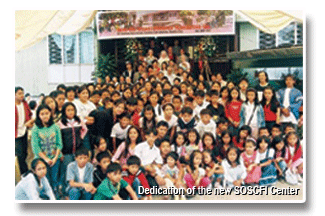
In that first year, COD met in large groups, small groups and individual sessions, with men and women of different ages, backgrounds and education. We called the student group ‘Seekers’ and the older group ‘Sojourners’ to differentiate them, but there was great freedom in mixing and mingling. Together we learned much about Ignatian discernment – the necessary conditions for it to be effective in one’s life, what is meant by discernment of God’s will and discernment of spirits. We explored the spirituality and practice of discernment, as well as positive and negative experiences. We talked about what discernment meant at various stages in one’s life, how God had a purpose and a ‘vocation’ for each one of us and that we would only be truly happy and satisfied in that path of life. One of our favorite quotes became ‘I know the plans I have for you, says the Lord, plans of peace and not disaster, reserving for you a future full of hope. When you seek Me, you will find Me, when you seek Me with all of your heart’ (Jer 29:11- 13).
Came the second year and COD kept right on going. This time, using discernment as a foundation, we explored how the theme of relationship – with God, ourselves and others – was fundamental to discernment. We talked about both wisdom and foolishness in relationship, about how easy it is to get tempted, mixed up and confused in relationship. We added to our monthly meetings retreats and panels where COD members could present their discernment or relationship cases so we could all reflect on them. Our membership diversified even more: married couples as well as young men and women in religious life, professionals, housewives, retirees, and so on. The Circles kept getting wider and broader.
The third year arrived – and I figured we had gone as far as we could. But no, from all our talk about discernment and relationship, the members chose to focus in Year III on virtue, asking what the virtues are that promote discernment and good relationship and the vices that destroy them. People said ‘Nobody talks about virtue any more – but it’s so essential!’ We looked at both good habits and bad habits from a personal, spiritual and social dimension. After all, getting insight into all these things is never enough. We have to practice them. Our hearts have to be converted and transformed so that our behavior is consistent with our belief. That’s what virtue and good habits are all about. Year III also saw the publication of our COD newsletter, Cabrini Companions, as well as various apostolic outreach programs to SOSCFI, medical missions and now prison ministry.
The Present Moment
So where are we now in 2007? Casa Cabrini is a thriving House of Discernment, SOSCFI has a new center, we have received international grants for our ministry and we have opened a second community in Baguio. Truly we have been blessed for which we thank and praise the Sacred Heart of Jesus.
And what about COD? At the end of our third year we had a major evaluation and formed a leadership team to see ‘Quo vadis, where are you going, Lord?’ Together we discerned that COD is not a movement or an exclusive club. Many of our members already belong to other groups, yet they keep coming to COD. Therefore, Circles of Discernment is above all a formation program for people like us who want to discern the will of the Lord and how we can live that out in our daily lives.
In planning Year IV, we decided that with this three-fold foundation of discernment, relationship and the practice of authentic virtue we already had ‘more than enough’ for our life journey with the Lord. So we made them the basis of a three-year cycle of formation for COD. We believe that these three essential elements are the foundation of a life of personal relationship with the Lord, of hearing and doing His Word and, above all, of seeking and carrying out His Will and purpose for each of us. This is our credo.
Year IV of Circles of Discernment had a very special beginning: our first two-day COD Assembly on Discernment at Jesuit Villa, given by Fr Ramon Bautista SJ. This was a graced moment for us which provided a wonderful foundation for all that is to follow. In addition to our regular meetings, we have also expanded our retreat programs. There are four this year.
Words from Our Members
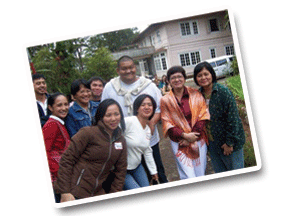
Here’s what some of our members have to say about COD:
Grace Calleja, a young entrepreneur has this to say: ‘I am a sojourner in Circles of Discernment. I joined the group three years ago. As I write this, I still haven’t lost the excitement and anticipation in my heart that I had when I was about to attend my first COD meeting. I know that every time I come out of a COD meeting, I will feel recharged, renewed and revitalized for another month-long struggle with everyday discernment’.
Richard Halaman, married with two sons and Director of Physical Therapy at Benguet General Hospital, wrote after a COD retreat: ‘Cherishing the moments of divine chance, I believe I’m in God’s hands. In my life, vices have turned to virtues, lukewarmness turned to devotion. God’s commandment has become absolute. Indeed, my spiritual formation is no less than a miracle!’
Rebecca Costales, professor at UP, Baguio, as she grew in relationship with herself and in self knowledge, had this to say of her COD experience: ‘I have realized that the more we stand naked in the eyes of God with all that is of us – the beautiful and the not-sobeautiful – God is delighted in this kind of honesty. After all, He does not seek to redeem the beautiful in us, but those gray areas that we like to hide. He desires the honesty that comes from within. I used to pray ‘Lord, take away this anger, this impatience, this and that sin. Take away my weaknesses . . .’ But now I have learned to pray “Lord, I am angry today, I accept my impatience, I failed again, for I am weak. Have mercy on me”.’
Jovie DeCoyna, one of the members of Casa Cabrini, our House of Discernment, had this to say of her experience: ‘Casa Cabrini is an ‘open house’ where people come and go. Some stayed and others went on but nobody who came into the community would say they did not feel at home. The openness and hospitality of the Sisters show that nobody who knocks at the door will be rejected. When I first walked into this house, I knew I had found a family, a unique family composed of people with different backgrounds and who came from various cultures, coming together to be a witness to God’s marvelous works.
And finally . . .
As for myself, as a Missionary Sister of the Sacred Heart and a daughter of Mother Cabrini, I am so happy that my original narrow intention was ‘hijacked’ by the Lord and expanded for His purpose. I am in awe at how our God works when we let Him. Perhaps this experience is a small example of what Pope John Paul II meant when he said that every religious house should be a ‘school of spirituality’ and a ‘laboratory of faith’ for all who come. Certainly this kind of ministry has become a mission in itself. Even though this was not our original intention, we MSCs are very happy that Casa Cabrini and Circles of Discernment have evolved in such a dynamic and creative way. We feel that the Lord is leading all of us on a journey of faith into a future filled with hope and love.
The mailing address of Sr Patricia
Spillane MSC is: PO Box 191,
BAGUIO CITY, 2600 Benguet.
Her email address is:
ps3816@skyinet.net